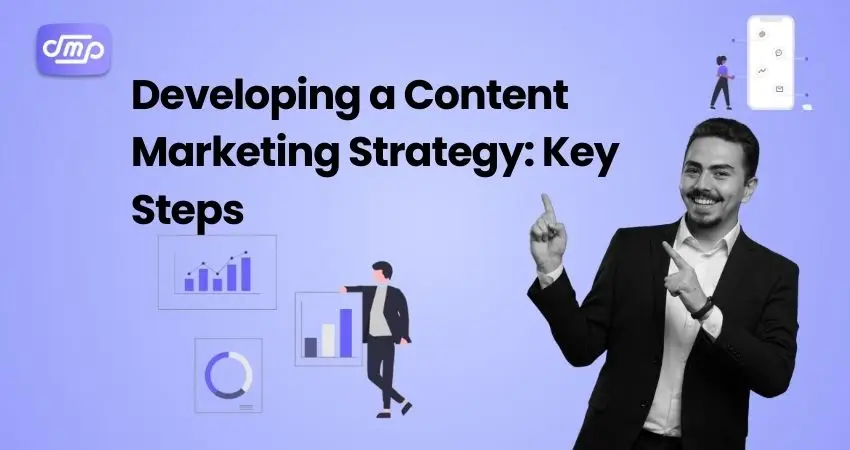
- June 28, 2024
- Digital Marketing
Table of Contents
A content marketing strategy is a detailed plan outlining how a company will produce, disseminate, and oversee content in order to accomplish particular marketing goals and objectives. Target audiences must be identified, their requirements and preferences must be comprehended, and content must be created that speaks to them at different points in the buyer’s journey.
Businesses may reach a larger audience by showcasing their knowledge, principles, and USPs through content marketing strategy. Developing insightful and timely material on a regular basis contributes to a rise in brand awareness and identification.
Businesses can interact with their audience more deeply by providing educational, amusing or inspirational content. Stronger relationships and brand loyalty result from providing customers with content that speaks to their needs and interests.
The following are the essential elements of a content marketing strategy:
Establish measurable, well-defined goals that are in line with your overarching business objectives. Some examples of these goals include raising brand awareness, generating leads, boosting sales, and establishing thought leadership.
Learn everything you can about the characteristics, hobbies, problems, habits, and preferences of your target market. Create thorough buyer personas in order to customise your material to their goals and objectives.
Choose the kinds of material that will most effectively pique readers’ interest and further your advertising objectives. Blog entries, articles, podcasts, infographics, films, webinars, case studies, whitepapers, social media pieces, and more might all fall under this category.
Provide valuable, pertinent, and high-quality content that speaks to the interests, problems, and inquiries of your target audience. Make sure that the messaging, tone, and style of each piece of content are consistent.
Determine which platforms and channels will best help you reach your target audience with your content. Your website, blog, social media accounts, email newsletters, trade journals, possibilities for guest blogging, and content syndication platforms might all fall under this category.
To increase your content’s visibility and ranking in search engine results pages (SERPs), optimise it for search engines by including pertinent keywords, meta tags, and SEO best practices.
Create a plan for promoting your material to broaden its audience and make it more visible. Utilising influencer relationships, email marketing, content collaborations, social media advertising, and other marketing strategies may be necessary to achieve this.
To monitor the effectiveness of your content marketing strategy, set up metrics and key performance indicators (KPIs). Track data on website traffic, engagement, lead generation, conversion rates, customer acquisition costs (CAC), return on investment (ROI), and other parameters.
To gauge the success of your content marketing strategy, examine the performance statistics on a regular basis. Make data-driven tweaks to optimise your content, distribution channels, and promotion strategies based on your analysis of what’s working and what needs better.
Adjust and improve your content marketing strategy on a regular basis in response to feedback, insights, and shifting market conditions. Try out different distribution methods, information formats, and strategies to be competitive and relevant in your field.
Businesses may efficiently accomplish their marketing goals, drive business growth, and attract, engage, and convert their target audience by creating and executing a well-defined content marketing plan.
Why Do You Need a Content Marketing Strategy?

Several crucial actions and factors must be taken into account when developing a content marketing strategy in order to guarantee its efficacy and alignment with your company’s objectives. Here’s a thorough guide:
- Establish Your Goals: First things first, be clear about the goals you want to accomplish with your content marketing strategy. Are you trying to build thought leadership, boost sales, create leads, or raise brand awareness? The remainder of your plan will be shaped by your objectives.
- Recognize Your Audience: Recognize the preferences, pain points, interests, and demographics of your target audience. Your choice of where and what kind of material to produce will be influenced by this knowledge.
- Perform an audit of content: If you have any content already, assess it to find any holes, places for development, and high-performing articles.
Establish KPIs or Key Performance Indicators:

Influencer and affiliate marketing appear to have bright futures, with several aspects influencing their development:
- Create Buyer Personas: Make thorough profiles of your ideal clients using psychographic and demographic data. This will enable you to better customise your material so that it appeals to particular audience segments.
- Select the Channels and Content Types: Choose content formats such as blog articles, videos, infographics, podcasts, and social media postings that best fit your target audience and objectives. Additionally, determine which media channels—such as websites, social media accounts, and email newsletters—your audience uses most frequently.
- Establish a Content Calendar: To guarantee consistency and relevancy, schedule the production and dissemination of your material. You should schedule subjects, forms, release dates, and accountable Topics, formats, publication dates, and accountable team members should all be on your schedule.
- Create Engaging Content: Provide top-notch content that speaks to the needs, interests, and problems of your audience. Prioritise adding value, resolving issues, and emotionally connecting with your audience.
- Make SEO-friendly changes: Use SEO best practices, meta tags, and pertinent keywords in your content to increase its exposure in search results and draw in natural visitors.
- Encourage and Disseminate: Reach your target audience by using a variety of distribution methods, such as influencer collaborations, email marketing, social media, and guest blogging. Adapt your distribution plan to the specific audience segments and platforms.
- Assess and Examine: Compare important indicators to your KPIs and use the results to improve content, adjust your approach, and analyze important indicators in relation to your KPIs, then use the results to improve content, hone your approach, and make informed choices.
- Improve and Iterate: Keep an eye on your content marketing strategy and make necessary adjustments depending on trends, customer feedback, and changing business goals. To remain ahead of the competition, try out fresh concepts, formats, and distribution methods.
You can create a strong content marketing strategy that produces results and builds enduring relationships with your audience by adhering to these guidelines and taking these factors into account.
Significance of Content Marketing Strategy
A content marketing strategy is essential for organizations in the current digital environment for several reasons.
- Increasing Brand Awareness: Companies can exhibit their knowledge, principles, and USPs through content marketing. Creating and disseminating good content on a regular basis promotes brand awareness and recognition among target consumers.
- Increasing Engagement and Traffic: Exceptional content draws users to your website, social media pages, and other online properties. Users can explore your offerings, engage with your brand, and become devoted followers or customers by giving them useful information and sharing compelling stories.
- Creating Leads and Conversions: The process of creating leads involves a lot of content marketing. Your target audience’s wants and pain areas can be addressed to pique their interest and lead them through the You can pique the interest of your audience and lead them through the sales funnel. Content that is pertinent fosters leads, establishes credibility, and eventually turns prospects into customers.
- Developing Thought Leadership: Producing perceptive and educational content establishes your company as an authority in your sector or speciality. You may gain the audience’s trust and set your brand apart from rivals by offering insightful information, study results, and professional comments.
- Building Customer Relationships: By offering value beyond your goods or services, content marketing strategy enables you to interact with your audience more deeply. Delivering informative materials, engaging narratives, or interactive experiences can help you create deep connections with clients and increase brand loyalty.
- Increasing Organic Visibility and SEO: Websites that consistently post high-quality, pertinent, and new information are given preference by search engines. Over time, you can raise your search engine ranks and draw in organic traffic by making your content optimized for relevant keywords and obtaining backlinks from reliable sites.
- Changing with the Times: Before making a purchase, modern buyers would rather learn more and conduct their own research. You can impact their decision-making process and remain at the forefront of their minds when they’re ready to make a purchase by offering insightful material that answers their queries and worries at various points throughout the buyer’s journey.
- Measuring and Improving Performance: With a clear content marketing strategy, you can use a range of analytics and metrics tools to monitor the effectiveness of your content. Via the examination of information like internet traffic, engagement rates, and conversion rates, You may make data-driven decisions to optimize your approach over time by identifying what’s working well, and what needs improvement, and analyzing statistics like website traffic, engagement rates, conversion rates, and customer feedback.
Conclusion
In today’s competitive digital marketplace, businesses that want to draw in, hold on to, and engage with customers must have a content marketing strategy. It offers a structure for producing worthwhile, timely, and coherent content that connects with your target market and yields measurable commercial outcomes.











